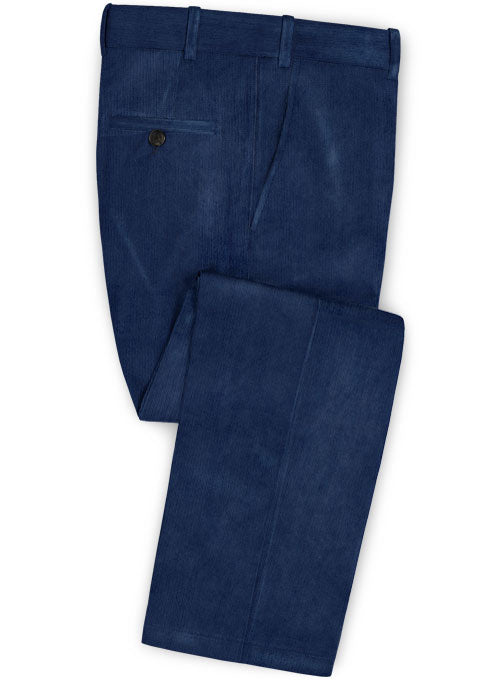Not all suit trousers are made of the same material. You can find suit trousers available in a wide range of materials, including corduroy and velvet. When viewed from afar, corduroy and velvet suit trousers may look the same, but there are several key differences between them. As a result, you might be wondering which material is best. In this post, you'll learn more about the differences between corduroy and velvet suit trousers, allowing you to make the right decision regarding your wardrobe.
What Are Corduroy Suit Trousers?
Corduroy suit trousers are characterized by a corduroy-ribbed surface. Upon hearing the term "corduroy," many people assume that it's a specific and unique type of fabric. Corduroy, however, is actually cotton featuring a heavy construction with long vertical ribs on the outer surface. If you run your fingers across a pair of corduroy suit trousers -- or any other garment made of corduroy -- you'll feel the raised ribs. All corduroy suit trousers feature this ribbed surface.
Being that they are made of cotton, corduroy suit trousers have a similar level of softness as other cotton trousers. What distinguishes corduroy suit trousers from cotton trousers is their ribbed surface. The front of the trousers has a long vertical ribs that you can both see and feel, whereas the front of traditional cotton trousers has a smooth surface.
What Are Velvet Suit Trousers?
Velvet suit trousers, on the other hand, are characterized by a weaving construction in which the fabric's cut threads are distributed evenly to promote an exceptional level of softness. Like with corduroy, velvet is also made of cotton. Velvet suit trousers are unique, however, because of their super-soft texture. The way in which the velvet suit trousers are woven makes them softer than suit trousers made of other materials.
If you run your hands across the surface of velvet suit trousers, you won't feel the same vertical ribs found on corduroy suit trousers. Instead, velvet suit trousers have a soft and smooth surface. All velvet is made with evenly distributed cut threads along with a short and dense pile. Weaving jargon aside, velvet is incredibly soft and supple material. When used in the construction of suit trousers, velvet carries these same benefits with it.
The Benefits of Corduroy Suit Trousers
Why should you wear corduroy suit trousers? For starters, many men prefer the unique appearance of corduroy over other common materials used in the construction of suit trousers. Corduroy suit trousers have long vertical ribs that distinguish them from other trouser materials.
It's safe to say that corduroy suit trousers will remain popular for many years to come. They were particularly popular during the 1970s and 80s. While corduroy suit trousers experienced a short decline in popularity throughout the 90s, they've since made a strong comeback. Today, you can find corduroy suit trousers worn by fashion-conscious men from across the world.
Corduroy suit trousers are also incredibly durable. The distinguishing feature of corduroy is the material's ribbed surface. However, corduroy is also heavy, thereby increasing its strength and durability when compared to other materials. With corduroy suit trousers, you can rest assured knowing they won't damage easily. You can wear them indoors or outdoors for multiple years, all without experiencing any damage to them. Other types of suit trousers can also last a while, but corduroy suit trousers are prized for their exceptional durability.
You might be surprised to learn that corduroy suit trousers are available with viscose lining. What is viscose lining exactly? Basically, viscose is a unique synthetic-organic hybrid material that's used as an alternative to silk. It features a similar level of softness as silk, making it super soft and, therefore, comfortable to wear. With viscose lining, corduroy suit trousers offer an unparalleled level of comfort.

The Benefits of Velvet Suit Trousers
While corduroy suit trousers offer a variety of benefits, you can't ignore the benefits of velvet suit trousers either. As previously mentioned, velvet suit trousers are super soft. It's difficult to describe the softness of velvet without feeling the material for yourself. It has an almost fuzz-like texture that's super gentle and soft.
Velvet suit trousers are also resistant to wrinkles. They aren't necessarily wrinkle-proof. However, velvet suit trousers are generally less susceptible to wrinkles than suit trousers made of other materials. If you're tired of getting dressed in the morning, only to discover that your suit trousers are wrinkled, you may want to try wearing velvet suit trousers. The wrinkle-resistant properties of velvet make them a great all-around choice.
Velvet suit trousers are easy to maintain. They are already protected against wrinkles. Moreso, velvet suit trousers can be dry cleaned. If you discover a stain or blemish on your velvet suit trousers, simply take them to a local dry cleaners.
Velvet suit trousers are available in several colors and styles. Regarding the color, black is a popular choice because of the ease at which it matches other colors. If you're struggling to choose a color for your velvet suit trousers, you should consider black. With black velvet suit trousers, you'll be able to wear just about any color for your suit jacket, dress shirt, necktie, shoes and other garments or accessories. Of course, you don't have to limit yourself to choosing black velvet suit trousers. You can find them in several other colors and styles.
In Conclusion
Corduroy and velvet are two common materials in which suit trousers are made. Corduroy suit trousers are characterized by the presence of vertical ribs on the front, whereas velvet suit trousers are characterized by a weaving construction in which the cut threads are evenly distributed. They are both great choices if you're looking to buy new suit trousers. Just remember to choose the right color, size and style for your personal needs.



